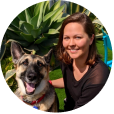Often we get to hear – “The first impression is the last impression” and arguably this holds true on how important it is to create a jaw-dropping artificial intelligence portfolio when applying for a position in artificial intelligence or machine learning domain. There are two important prerequisites for AI jobs: the required artificial intelligence skills and an impressive artificial intelligence portfolio to prove you actually have them.
Whether you’ve just graduated from Springboard’s Artificial Intelligence and Machine Learning program or are looking to land a top artificial intelligence job, you already know how important an artificial intelligence portfolio is. Without one, hiring managers and employers won’t have any way to gauge your artificial intelligence skills. A robust artificial intelligence portfolio is the most important weapon to have that competitive edge over others that merely depend on experience and certifications to get through the job door.
If you’re a beginner in artificial intelligence and lack years of experience, this article is for you. It will tell you how to build a stunning artificial intelligence portfolio that will get the interview doors open and help you win the job. Even if you aren’t new to artificial intelligence, it is important not to neglect your artificial intelligence portfolio. Maybe you have a PhD in Math/Statistics, and have completed some remarkable AI projects on NLP or Computer Vision – all the more reason to update your artificial intelligence portfolio is to better build off your experience in AI. No matter at what experience level you’re in your artificial intelligence career, it is at all times important to have a portfolio to show off your work and AI projects you’ve collaborated on, what you like to do, and your professional career growth goals.
Artificial Intelligence Portfolio – Getting Started
Here at Springboard, we’ve written a lot about what to include in your data science portfolio and machine learning portfolio. And it’s a worthy topic to discuss! Data science and machine learning portfolios are like eye candy. Toss in some cool projects to showcase your data science and machine learning skills and boom! You’ve got a great portfolio that employers can drool over. However, an Artificial Intelligence portfolio can be a little more mysterious. Are prospective employers or hiring managers really going to be impressed by a couple of projects that demonstrate one or two artificial intelligence skills? And how do you even show them the projects you’ve made? A bunch of projects on spam detection, housing price prediction, or iris flower classification that work really well and are good to wrangle about. That’s not likely to leave many prospective employers impressed as these are some run-off-the-mill projects for learning the rudimentary concepts and when it comes to creating an artificial intelligence portfolio, it should be stellar. You’ll need a rockstar artificial intelligence portfolio to impress the recruiters and build a rewarding artificial intelligence career.
What Employers look for in an Artificial Intelligence Portfolio?
When prospective employers screen for AI engineers, there is a certain set of criteria they will be looking for. They want to know:
- Which programming languages you are proficient in Python, R, Java, or C++?
- What is your efficiency level in distributed computing?
- Which organisations you have worked with?
- What quantifiable results you have achieved in your projects?
- Do you have superb problem solving approach and analytical skills?
An artificial intelligence portfolio should address these questions with tangible evidence in the form of functional artificial intelligence and machine learning projects. The portfolio projects should showcase the libraries you are familiar with, artificial intelligence and machine learning tools used in the project, the end-to-end functionalities of the project, and how you built artificial intelligence projects.
Get To Know Other Data Science Students
Isabel Van Zijl
Lead Data Analyst at Kinship
Samuel Okoye
IT Consultant at Kforce
Sam Fisher
Data Science Engineer at Stratyfy
Tips for Creating an Impactful Artificial Intelligence Portfolio
-
Keep Your Specialised AI Skills in the Spotlight
-
Choose Your Best Work for the Artificial Intelligence Portfolio
-
Document All Experiments and Analysis
-
Knowledge is Power – Share Knowledge
-
Add Testimonials and Recommendations
Now let’s get started on how to make an effective artificial intelligence portfolio that you will help you get your dream artificial intelligence job.
1. Keep Your Specialised AI Skills in the Spotlight
Artificial intelligence includes a lot of different disciplines like machine learning, computer vision, natural language processing, knowledge management, deep learning, planning and reasoning, distributed computing, and more. Artificial intelligence portfolios that just say, “I have all AI skills under my belt” are going to miss out on employers looking for specific tasks you do. Just get a bit technical here and mention your specific AI skills and how you have acquired them. Employers who don’t know about the technicalities you’re referring to will just be impressed, and others who know are most likely to appreciate your specialised skills knowing upfront what AI skills you have and what you don’t.
2. Choose Your Best Work for the Artificial Intelligence Portfolio
Projects are the crux of an artificial intelligence portfolio so ensure that you don’t share every project you have ever completed. Mentors at Springboard recommend that one should select a sampling of at least 5 projects in an AI portfolio that represents the depth of their experience and the level of AI skills. Once you have identified your specialised skills it’s time to begin building your portfolio by including projects relevant to the specialised AI skills and then include generic projects that demonstrate your overall AI skillset. One of the best ways to grow your skills when you’re just starting out in your AI career is to get involved with projects on Kaggle, GitHub, or start your own. GitHub is the go-to open-source repository for the majority of data science, machine learning, and AI enthusiasts out there. Choose to work on projects in the domain that interest you, it could be healthcare, sales, transportation, agriculture, e-commerce, manufacturing, or any other domain. Having chosen the domain, the next thing is to choose your focus areas such as deep learning, computer vision, NLP, or advanced machine learning.
Every project that you include in your AI portfolio should include a snapshot with the following details –
- Project name and description
- Dataset used for the project
- The objective
- Data science and machine learning tools used
- Category of the project – neural networks, NLP, computer vision, deep learning, etc.
- Link to the code
- How to run and test the code?
3. Document All Experiments and Analysis
A good documentation practice is to write a blog about each project that you have done so that it crystallises your thought-process and makes it easy to share with your prospective employers. Document all the analysis you have done and the techniques you have applied. Remember not to just document the success stories, also write about the failed methods/techniques along with reasons on why a particular method did not work for a given problem. Also, ensure that you add detailed comments for each piece of code to show the various paths you take to solve a problem. Adding good comments to each project is important because it helps potential employers see how you work and if this way is going to be effective for their team if they hire you.
4. Knowledge is Power – Share Knowledge
Your artificial intelligence portfolio should share all your learnings, be it from the last job, or from reading top AI and machine learning books or from the latest project you worked on. This is a proof of evidence that you love to explore novel concepts and like to share the learnings with others. A research paper could be a great addition to an artificial intelligence portfolio because any new development in the world of AI begins its journey from a research paper. Research papers, blogs, vlogs, courses, conferences, publications, and community participation act as a massive boost in the portfolio.
Say, for instance, you have recently acquired knowledge from Springboard’s AI and Machine Learning program so you can add your learning in the portfolio. You can also add about any new concept you learned from any book or source and how you applied that concept in solving a real-world problem.
5. Add Testimonials and Recommendations
Speaking of testimonials, if your previous employers or freelance clients are impressed with your work, request them to write a testimonial about why they liked your work. LinkedIn profile is the best way to showcase your expertise with testimonies approved by others. Also, mention the top AI influencers, experts, and leaders you like to follow and whose work you admire to show that you keep yourself immersed in the AI world and are interested in building a career in AI.
Avoid These Big Mistakes In Your Artificial Intelligence Portfolio
Always looks for these pointers once you are done building your artificial intelligence portfolio –
- Bits and pieces of code done by other people – The projects that you include in your AI portfolio should be yours. Considering that AI is still an evolving field, sometimes it might not be possible to include your code without including the work of others. Under such circumstances, always give due credit to someone else’s code after seeking their permission with a reason on why you’re including it.
- Poor descriptions of the AI and ML projects – One key skill of being an artificial intelligence expert is being able to explain the code, functionalities, and findings to the stakeholders and peers. If your artificial intelligence portfolio does a poor job at this then it gives an impression to the employer that this trend will carry through if you are hired.
- Lack of New AI Projects and Inactivity – Artificial intelligence portfolio needs to be updated constantly to provide an assurance to the employer that you upskill yourself with the latest tools and technologies and that your knowledge is current enough to keep up. If the portfolio is not updated constantly and the potential employers see any gaps of inactivity they might assume that you have not done any novel project for quite a few months.
Take The Next Step and Build Your AI Portfolio
Updating your resume, creating an artificial intelligence portfolio, and building network connections can be time-consuming but it’s worth the time to land a top gig as an artificial intelligence expert. If you’re considering transitioning to an artificial intelligence career, let Springboard be your go-to resource. A comprehensive artificial intelligence program from Springboard is a great way to build an artificial intelligence portfolio and connect with recruiters.
Recommended Reading: Data Scientist Job Description
Since you’re here…Are you interested in this career track? Investigate with our free guide to what a data professional actually does. When you’re ready to build a CV that will make hiring managers melt, join our Data Science Bootcamp which will help you land a job or your tuition back!






